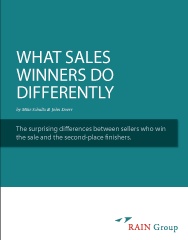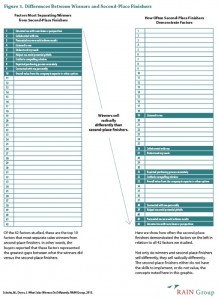Pain, Brain, or Reframe? How do Buyers Really Buy?
If you’re interested in selling, you might plausibly start with trying to understand how buyers buy. It’s a simple enough question. But then why are there so many answers?
Three of the most common answers to that question are:
- People buy when they strongly feel a desire to alleviate a negative situation.
- People buy as a response to a clear value proposition.
- People buy most from those who offer differentiated, out-of-the box, creative solutions.
For short, let’s call those Pain, Brain, and Reframe, and examine them in turn.
The Pain Model
Many sales writers say things like these two quotes:
“The customers that are most likely to convert have a pain that they need to alleviate. Now.”
or
“Solid, smart sales are focused on our clients’ pain points, not on the tech demo.”
Within the Pain category, there is an internal debate about whether the prospect of a better situation can be as motivating as alleviating a painful situation. (One solution: reframe the gain as alleviating a potential pain.)
The Brain Model
Many other salespeople consider “value propositions” to be the key driver. Consider, for example, Investopedia’s definition of value proposition:
“A business or marketing statement that summarizes why a consumer should buy a product or use a service. This statement should convince a potential consumer that one particular product or service will add more value or better solve a problem than other similar offerings.”
Or consider this one from a sales training firm:
“Customer contact professionals must be engaged and expected to adapt a financially oriented value proposition to the customer or prospect.”
Many fans of value propositions suggest they are best used as conceptual maps for marketing and not as sales collateral. But this distinction is lost or ignored by a great number of salespeople.
Note that nearly the entire economics profession is built around the idea of rational economic choices. In my experience, greater exposure of salespeople to economics or MBA programs translates to greater reliance on the Brain model of selling.
The Reframe Model
One constant need among buyers is to de-commoditize their business. “What have you got that’s new?” is a powerful and relevant question for them, and sellers who have an answer will generally get a hearing.
The Challenger sales approach is a good example of this model:
They have “a deep understanding of the customer’s business and use that understanding to push the customer’s thinking and teach them something new about how their company can compete more effectively.”
This approach has some justification in business strategy, where the attempt to gain differentiation is an alternative to the low-cost producer strategy.
So, what is the truth? Are buyers motivated by the desire to remove pain? By a rational statement of value? By a compelling new way of articulating issues?
What’s best? To soothe the pain, appeal to the brain, or reframe the game?
Making the Buying Decision
If clients make buying decisions because of rational calculations, then the Brain model would appear to be the best. If buyers are looking for access to new, differentiated ideas—and the people who bring them—then the Game-reframe model looks best. And if buying is mainly motivated by emotional issues, then the Pain model is best. The question, therefore, becomes: which underlying psychological model best explains the process buyers undergo.
Of course, simple choices like A, B, or C often end up being solved only by rephrasing the question. This is no exception. For example, consider the buying decision as a multiple-step decision, or a multiple-psychology decision, rather than a single-step decision.
Different Buying Stages: In The Trusted Advisor (written by David Maister, Charles Green, and Rob Galford), we note that complex services buying decisions are typically two-step decisions. The first step is screening to identify plausible sellers. The second step is selection. Bill Leigh of the Leigh Speakers Bureau tells the story of one client’s decision process to hire a speaker for a major corporate event:
“They quickly narrowed it down to two—either Michael Porter, a major business strategist, or Lester Thurow, a prominent economist. They went back and forth until finally they agreed on a solution—ex-Chicago Bears football coach Mike Ditka.”
The first step is a relatively rational process of data-gathering. That process sounds very much like the Brain model.
But the selection step is taken much more emotionally, involving a complex set of cross-currents. That sounds more like the Pain model. (Or if you consider Ditka a redefinition of the problem, it’s more like the Frame model.)
Different Buying Psychologies: Another approach to splitting the A/B/C dichotomy comes from a large study by Bill Brooks and Tom Travesano, reported in You’re Working Too Hard to Make the Sale. Looking over thousands of sales across several B2B buyer types, their conclusion was summarized in one powerful sentence:
People buy what they need from those who understand what they want.
In other words, the identification of needs (systems, audits, legal advice) is fairly straightforward—the Brain model. But the actual choice is made on the basis of which seller most deeply taps into buyer wants—fears, hopes, aspirations, wishes, desires. It is not necessary that those wants be satisfied; it is enough that they are recognized, understood, and acknowledged. Doing that drives the decision to buy what, after all, has to be bought anyway.
Integrating Buying Psychologies: Neil Rackham, via his classic SPIN Selling, offers yet another insight, one that integrates the various models. SPIN (Situation, Problem, Implications, Needs-Payoff) operates at one level on a buyer’s emotional needs by forcing sellers to listen to the customer before they start offering solutions. At another level, it is a very rational model, methodically identifying both pain points and alternative, potentially breakthrough conclusions.
What’s the Answer?
Perhaps the last word may come from science fiction author Robert Heinlein, who is credited with saying, “Man is not a rational animal: man is an animal who rationalizes.” Putting it into sales terms, “People buy with their heart and rationalize it with their brains.”
That is not to minimize or discount the role of rational decision making. We all acknowledge rational analyses as important checks against the mistakes we might make if we rely solely on the emotions. At the same time, it recognizes the powerful role that emotions play in human decision making, of which the buying decision is just one.
The most useful answer is, “Develop a rich, insightful, trusting relationship with your client, and be prepared to offer them all the legitimate backup they’ll need to defend their decision to buy from you.”
This article was first published in RainToday.com

 This is the first of a four-part blogpost series. In
This is the first of a four-part blogpost series. In 
